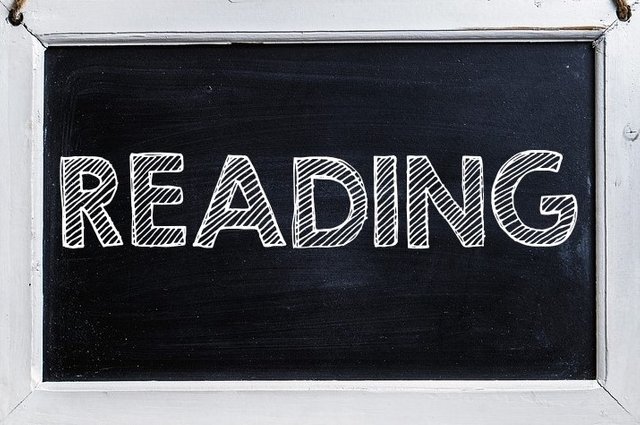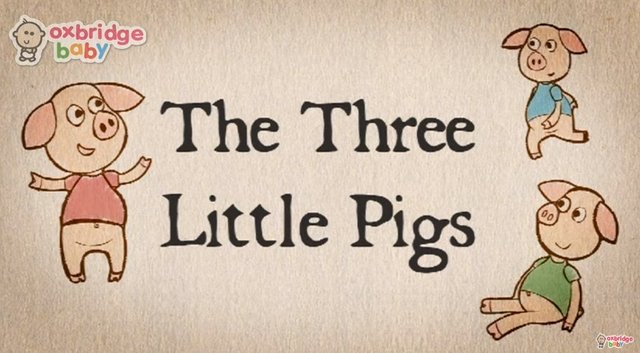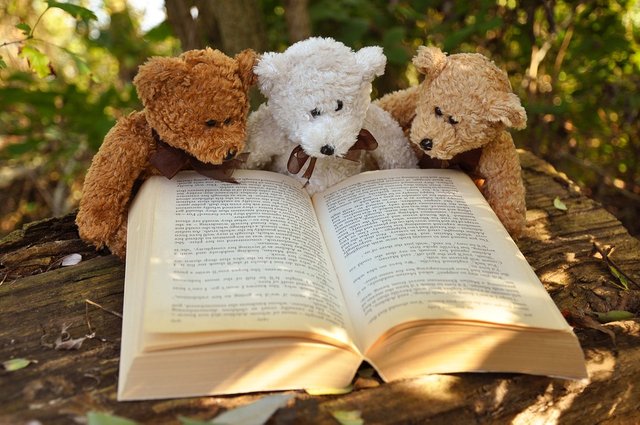
When I read stories to children, they often act out or participate in the actions of the book without even thinking that they're doing it. They just spontaneously move or make noises or sounds as they allow themselves to become part of the story. They also feel the characters' emotions such as happiness, sadness, anger or disappointment. Whilst all this is happening, they are also developing important literacy skills such as listening, rhyming words, vocabulary, characterisation and story sequencing. Apart from that, they are also practicing social interaction and cooperation.
Last week, we revisited the story "The Three Little Pigs." I think at this stage, this is their most favourite among all the other books that we have read so far. When I asked them what the story was all about, they were able to use fundamental literacy skills to follow the sequence of the story from start to finish. They knew which little pig built the straw hat, the sticks house or the bricks house, and which one was built first. They were able to make comparisons of the different houses that the three little pigs built, and they also learnt the importance of being together and working as a group.
Enjoying and livening up story reading is essential to reading comprehension skills. When children have fun, they are more open to learning because they are not bored.
The following dot points are strategies that I use in my classroom to make reading fun and meaningful for the children, but parents can also do these strategies at home:
I always revisit a favourite story.
Not only that it is fun, because the children already love it, but I get the opportunity to check their understanding of the story when I ask them, for example, what happened first in the story, or what happened next, or how the story ended. By asking them, I am also allowing them the opportunity for verbal language and cognitive skills development.Music and movement are incorporated into the story.
I encourage children to suggest sounds, songs or movements that they can use to illustrate the story. I also offer them basic rhythm instruments, e.g. sticks, stones, to make noises or sounds to represent different characters of the story, their actions, or sound effects. For example, in the story The Three Little Pigs, children make blowing sounds as the Big Bad Wolf blows the house down. Or they tap their legs when characters of a story are running fast.
I invite children to look around the room for props that they can use to enhance their movements and characterisation.
In our classroom, we have a "home corner" where children are provided with different toys, dress-ups, and costumes so they can engage in imaginative play themselves. They use some of these toys in our story reading.Children can choose roles or jobs.
For example, I ask children who would like to to do the movements and who would like to make sounds. Then, I read the book again whilst children sing, move, and make their own sounds. Each repetition of this experience creates a new and deeper literature learning for children.With parents' permission, I videotape the retelling of the story and share it with the parents and children.
Children feel a sense of pride and satisfaction when they watch themselves on screen. The parents also love watching their children's learning journey.I use familiar stories.
Aside from revisiting the children's favourite story, I also intentionally choose to read classic stories that are also excellent for movement and music because most children already know or are familiar with them. Examples of these are:
** We're Going on a Bear Hunt
** Little Red Riding Hood
** The Three Bears
** Three Billy Goats Gruff
** Nursery Rhymes
Adding some sparkle to a traditional activity such as reading can definitely help change the learning atmosphere of the children. It's just up to us how we are going to execute and put it into practice to make learning more fun and engaging.
Is there anything that you are already doing that is not included in my lists of strategies? What books can you recommend to me to explore with movement and music? Please leave a comment below for your feedback or additional ideas and insights. Thank you for reading!
.png)
Some people that I follow: @dynamicshine (my sister), @puregrace, @ryl, @scarletmedia, @shagungupta, @shanu, @dynamicgreentk, @pkalra, @bunnychum, @honeychum, @ntowl, @mhm-philippines, @eaglespirit, @joanna-godfrey, @norma-jean, @quochuy, @yati, @rabiujaga, @baa.steemit
.png)



Thank you @baa.steemit, @steembulls and @terminallyill for the Discord banners, respectively.
Vote @cloh76.witness, @steemgigs, @pharesim, @quochuy, @mahdiyari, @yabapmatt, @blocktrades, @utopian-io, @furion, @themarkymark, @hr1, @curie, @qurator and @ausbitbank for witnesses!



The interaction is what I loved about reading to children. It's sad when a teacher tells them they can't interact and have to sit still. It seems more like a recipe for putting them off reading.
When my eldest was very little I used to read her Meg and Mog books. Once she started speaking she'd parrot along with me and then she'd recite each page as we turned to it. The sound effects were always the favourite and she'd act them out too!
Downvoting a post can decrease pending rewards and make it less visible. Common reasons:
Submit
Yes, some children when asked to sit still and listen, they actually pay less attention. They need to be engaged and be involved in the story so reading is fun and not monotonous.
Thanks for mentioning Meg and Mog. It is a good book series. I have to ask my Director though if I can read those books to the children as I work in a Christian school. There are books that we don't read as per school policy.
Downvoting a post can decrease pending rewards and make it less visible. Common reasons:
Submit
This post has been upvoted and picked by Daily Picked #45! Thank you for the cool and quality content. Keep going!
Don’t forget I’m not a robot. I explore, read, upvote and share manually 😊
You can upvote, follow, resteem, delegate and join my curation tail to support me, good creators and minnows.
5 SP 10 SP 20 SP 30 SP 40 SP 50 SP 60 SP 70 SP 80 SP 90 SP 100 SP
Thank you!
Downvoting a post can decrease pending rewards and make it less visible. Common reasons:
Submit
Thank you @dailypick!
Downvoting a post can decrease pending rewards and make it less visible. Common reasons:
Submit
Great tips.
Reading in school was often a chore because a lot of us didn't care for a lot of the stories we were reading, but when we read Shakespeares works around 8th grade and could choose roles to play in it, it started to be really fun and we all looked forward to the next lesson
Downvoting a post can decrease pending rewards and make it less visible. Common reasons:
Submit
Yes, and because of that you could identify yourself in the roles of characters in Shakespeare's plays and were able to enjoy his literature. Children are easily bored by conventional reading. They need to be motivated and learning has to be interactive and fun.
Downvoting a post can decrease pending rewards and make it less visible. Common reasons:
Submit